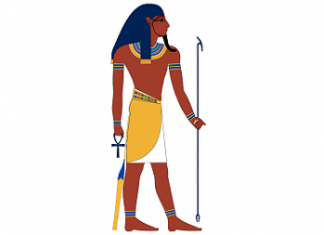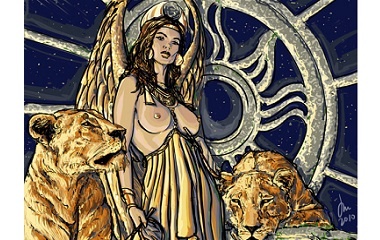- Pronunciation: Ee-na-na
- Origin: Sumerian
- Role: Goddess of sex, war, fertility and sensuality
- Parents: Enki or Nanna and Ningal
- Husband: Dumuzi
- Symbols: Eight-pointed star, lion
Who Is Inanna?
Inanna, slso known as Ishtar in Akkadian mythology, is a goddess associated with the morning and evening star, Venus. She is viewed as both an independent, powerful and sensual figure, but also as a young girl under patriarchal control. The goddess is also noted for her dual-nature – her feminine as well as masculine traits.
Origin
Inanna was originally worshiped as a vegetation deity but was later raised to the status of Queen of Heaven, the Mesopotamian’s most favored goddess. In Uruk, she was worshiped as their patron deity, especially at the main center, the Eanna temple (meaning the House of Heaven). The goddess was connected to Uruk, dating as far back as the Uruk period of 4000–3100 BC.
Legends and Stories
The poems of Inanna, such as the Descent of Inanna, carry her qualities through to the ritual and ceremonies in her honor. The sacred marriage of Inanna and Dumuzi was celebrated at the autumn equinox, in order to bring fertility to the lands. The king and priestess would reenact the sexual union of the god and goddess either symbolically or perhaps through actual intercourse.
Inanna and the Huluppu-Tree
In this early creation legend from the epic poem Gilgamesh, Enkidu, and the Netherworld, Inanna is depicted as a young girl. The goddess spots a Huluppu tree on the banks of the Euphrates River and wants to create a throne from the majestic tree. She replants it in her own garden, but later discovers the tree has been filled with nefarious entities: a serpent, Lilitu (a female demon believed to be an early version of Lilith in Jewish mythology) and a Zu-bird. Inanna is distraught and elicits the help of her brother, Gilgamesh. He kills the serpent, sending the other two creatures fleeing. He and his friends then chop down the tree and carve it into a throne and bed for her.
Inanna and Enki
In the story of Inanna and Enki, the goddess steals the meh, the rules for civilization, from her father Enki. She gets the god Enki drunk in a drinking competition and escapes with the meh. She takes them to her city, Uruk. The meh was a powerful tool and included all aspects of humanity, such as law, prostitution, victory, truth and writing. With the meh in her possession, her influence became greater and she was more powerful than ever.
Inanna and Sukaletuda
In this celestial myth of Inanna, a gardener, Sukaletuda is the antagonist. He is a terrible gardener and all the plants he cares for seem to perish. The only plant that survives is a large, shady poplar tree. Inanna spots the luscious tree and decides to have a nap beneath it. The gardener is awestruck by the magnificent goddess. He undresses her while she sleeps and has sexual intercourse with her. When Inanna wakes, she realizes what has happened and goes in search of the perpetrator. She curses the land with plagues so the people may reveal the villainous character to her. With Enki’s help, she finally finds the gardener, by spreading herself across the sky, following the course of Venus. Sukaletuda pleads his case, but the goddess is determined his punishment is death.
Family
Inanna is an important figure in Sumerian mythology. Along with Enki, Ninhursag, Nanna, Anu, Enlil and Utu, she forms part of the seven divine powers who formed the basis for many gods that followed. Her parents are said to be either Enki or Nanna and Ningal. The goddess also has a sister named Ereskigal and a husband, Dumuzi.
Appearance
In iconography she is shown as a gatepost or reed bundle, to represent abundance and fertility. She is often depicted as a naked female, in her human form. As a goddess of war, she is seen in a robe with weapons at her shoulders and battle armor. She is also shown next to or riding a lion, a reflection of her courage.
Modern Influence
Before the reign of King Hammurabi of Babylon, between 1792 and 1750 BC, women were regarded as equals. Inanna is an excellent example of this in the Sumerian pantheon. She became known as Ishtar in the Assyrian and Neo-Assyrian era and managed to endure the rising patriarchy, by not being replaced by a god as many other goddesses were. This has led to her being an icon in modern feminism.










